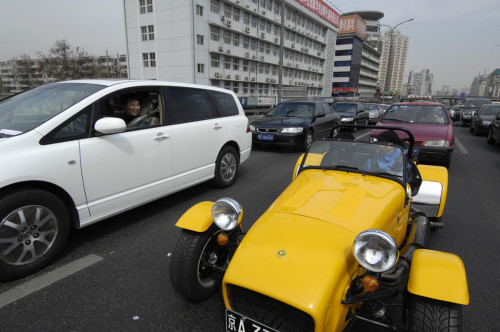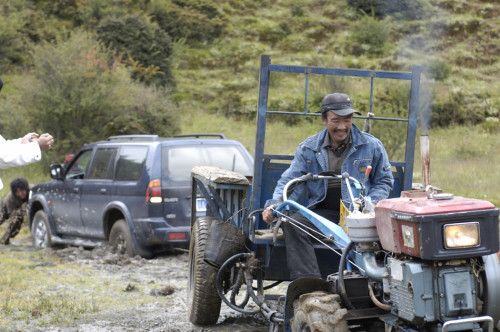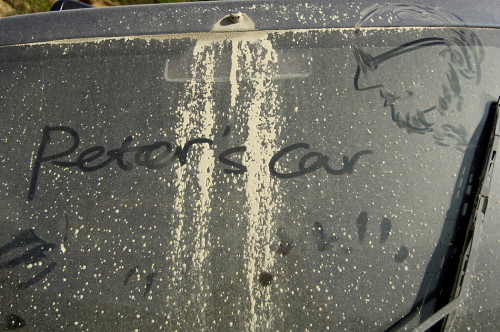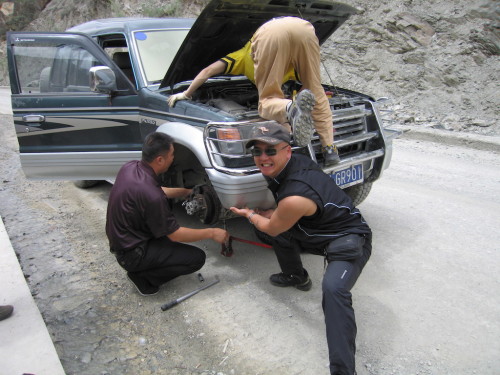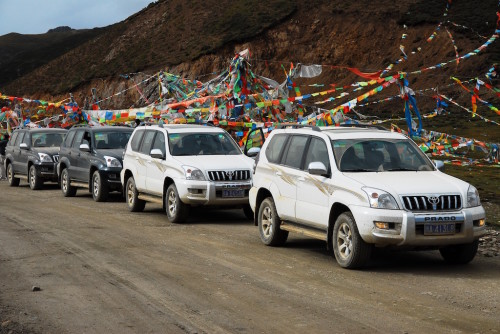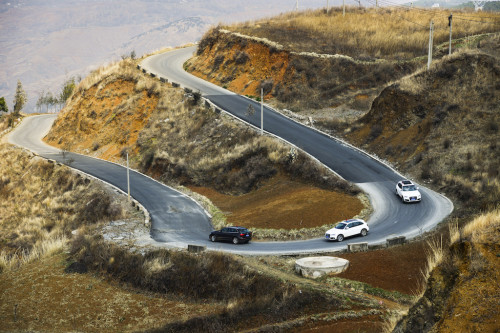The first car I ever drove in China was one I owned. This was bug-eyed Miss Daisy (or 小黄 in Chinese). A Caterham Super 7 R300, she was the granddaughter of Colin Chapman’s Lotus 7, a car meant for the track that had somehow finagled a public road worthiness certificate. The R300 was sold as a kit you could assemble yourself; for less mechanically minded drivers, Caterham also sold a fully assembled version.
Getting this car into China and equipping it with a proper (no-funny-money) Beijing license plate took a year. When the customs official laid eyes on her at the port in Tianjin, he laughed, saying, “That’s not a car, that’s a toy!” (这不是个车,这是个玩具). It took six months to convince him otherwise.
Next came the ordeal of going through what in the UK is called “single vehicle approval”, that is, the procedure of registering an unusual car. (At the time there was only one Caterham in China, mine.) I was prepared to hear many official reasons why Miss Daisy might not be licensed, except for the one that I was given: that she did not meet the city’s emissions standards. Yes, Beijing, one of the world’s more polluted capitals, has stringent emissions standards in place. It took another six months for her to pass the test. (You can read about my journey through China with Miss Daisy here.)
As a result of this prolonged and stressful experience, I concluded that renting cars – even though they might not be as special as Miss Daisy – was the way to go.
And so when I had the opportunity to drive in Sichuan, my friends and I rented a car in Chengdu. Back in 2005, this was my first lesson in renting cars in China. I got myself in trouble on day one when I found myself being pulled out of some mud by a tractor. There are many reasons – including my own stupidity – why this happened, but the main reason, to my mind, was that the letters “4WD” were emblazoned on the rear door of the SUV. Surely a four-wheel drive could tackle a bit of mud? Perhaps, were it not for the fact that the “4WD” was an expression of the carmaker’s aspiration – mere decoration, rather than a statement of fact.
Not long after this I rented another SUV in Chengdu. I had arrived a day earlier to take care of some business, then the following day I picked up the car and raced to the airport to meet my wife. The car ground to a halt shortly after the tollbooth on Chengdu’s airport expressway. “What the hell?” I grumbled, “How on earth can I be out of petrol after less than 15km?”
After a kind gentleman helped me fetch a canister of petrol, I picked up my wife – who was fuming – and drove straight back to the rental car company to complain. The store manager looked at me as if I came from another planet. “You pick it up empty, and you return it empty, that’s how it works,” he explained. “Not where I come from! You pick it up full and return it full!” He looked at me with an expression that said “Well, you’re in China, not wherever it is that you come from…” and was about to move on from the incident when he decided that I needed an explanation. “We can’t do it like that, Sir. Actually, we tried. But it didn’t work. Many cars would be returned with the fuel gauge needle showing that the tank was ‘full’.” I smiled, thinking smugly, “See, it works!”, but he continued: “Yes, the tank was fuel, but what was in it wasn’t petrol!”
For our first few journeys with customers, we used “rental SUVs” we had procured for our guests. The trouble was, I later discovered, that the “rental SUVs” where, in fact, not rental cars, but private cars that the owners had made available to the “rental car company” to be let to customers. Luckily, we were never stopped by the police to check, and we didn’t have any accidents – the insurance would promptly have refused to pay, I was told.
How do you start a driving holiday business in an environment like this? In 2008 we decided that we needed good, properly licensed cars: it was the beginning of our good relationship with Avis China. We got what we wanted – new Toyota Prado 4.0ls, rental license and all. But there was one snag: we had to lease them for five years. This was good for our guests and good for our reputation, but bad for the company’s pocketbook as we didn’t have enough business to utilize these gems fully.
By 2013 Hertz (but sadly not Avis) began to purchase Toyota Highlanders for their short-term rental fleet in Kunming. We have been using these ever since, but now there is another snag: while overseas rental car fleets are frequently renewed (usually in less than six months, in some cases in as little as three), the Hertz Highlanders from two years ago are still in the fleet, and they show it. Everywhere in the world we humans has been equipped with a mental switch that flicks between two positions; “I own it, I care”, and “It’s a rental, for Christ’s sake, who cares?” In China the two switch positions – while gradually approaching each other – are still very far apart.
Last year, the boss of Avis China moved from Avis to DCH (大昌行) Motor Leasing, a subsidiary of one of China’s largest listed companies. He called us and said “I’ve got news for you!” As a result of his move and our long relationship with Avis, we’re now able to offer our clients the option to upgrade to brand new Audi Q5s. 一步一步 (“one step at a time”) things are getting better indeed!
